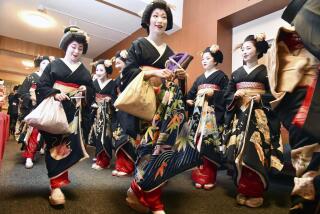A Vanishing Folk Art Tells Japan’s Story : Culture: Storytellers surrounded by children on Japan’s busy streets show pictures and sell sweets. But they can’t compete with video games or the need to cram for school classes.
- Share via
TOKYO — Click! Clack! Clack!
Sadayoshi Morishita is beating wooden clappers together in a small Tokyo park. It’s a beckoning sound, one that is vanishing rapidly in Japan.
Morishita is about to begin kamishibai, the 60-year-old traditional art of storytelling with pictures.
The click-clack is the signal for children to come and listen to colorful tales told by a professional storyteller. The listeners also buy his rice crackers, lollipops and fried noodles.
But as audiences have diminished over the decades, many of Japan’s old-time storytellers have given up their craft. Morishita attracts only a dozen or so children on average.
“Until the television arrived in 1953, movies and kamishibai were the only fun,” says 75-year-old Morishita, who used to amuse 50 to 100 children and adults every day.
“Since kids were hungry for fun, they waited for me, anticipating what would come next,” he says.
But the pressure to attend university has led even grammar school children to spend time after school attending special cram courses.
In addition, says Morishita, “There are many more types of food and fun, such as video games.”
Forty years ago, an estimated 30,000 people in Japan earned a living by telling stories and selling sweets. But as Japan developed industrially, many storytellers left for better jobs.
He takes to the street every day on an old bicycle outfitted with a self-made wooden chest filled with sweets and pictures.
“I do this because I want to exercise and earn some money,” he says with modesty. But he also clearly enjoys enchanting young audiences with a voice that changes from cheerful boy to feeble princess to threatening thief.
Morishita usually starts a tale with the antics of a boy named Chon-chan, then follows with the story of a samurai warrior. With so few original kamishibai pictures left from the 1930s, when the craft became popular, Morishita uses color copies.
“These stories and pictures are well-made and survive over many years,” he says.
“Children are not necessarily excited by the stories themselves,” says kamishibai expert Chizuko Kamichi of the Children’s Culture Center in Tokyo. A samurai story 30 years old can be quite outdated for youths who wear Western clothes and eat McDonald’s hamburgers.
Then why do they come? For the inexpensive snacks, perhaps. “I think it’s fun for kids to bring a hundred yen (75 cents) and buy three 30-yen sweets while they play,” she says.
Kamishibai, which evokes feelings of nostalgia from many older Japanese, was once a target of criticism. Commuters complained that the street shows with their big audiences blocked transportation. Parents were concerned about the cleanliness of the sweets and the possibly sensational pictures.
During World War II, storytelling was used by the government for propaganda purposes. Morishita’s father, for example, used kamishibai to exhort Japanese to live a frugal life and unite in the war effort.
But educators like Kamichi cite positive aspects of kamishibai and hope to preserve it.
“For small kids who find it difficult to understand a story . . . kamishibai helps them create an image about the story,” she says. And, compared to reading a picture book, “you can really talk to children in kamishibai, “ she adds.
Kamishibai’s chief benefit may be the generation-bridging effect it has. Kazuhiro Matsuzaka, another fifth-grader, says he goes to kamishibai almost every day because of Morishita: “I like that guy.”
But most likely, no one will follow in Morishita’s footsteps. With a laugh to hide his sadness he says, “I guess this aspect of Japanese culture will naturally disappear.”
More to Read
The biggest entertainment stories
Get our big stories about Hollywood, film, television, music, arts, culture and more right in your inbox as soon as they publish.
You may occasionally receive promotional content from the Los Angeles Times.










